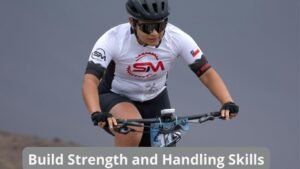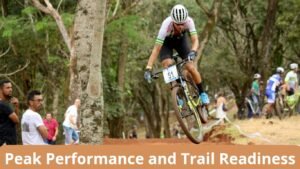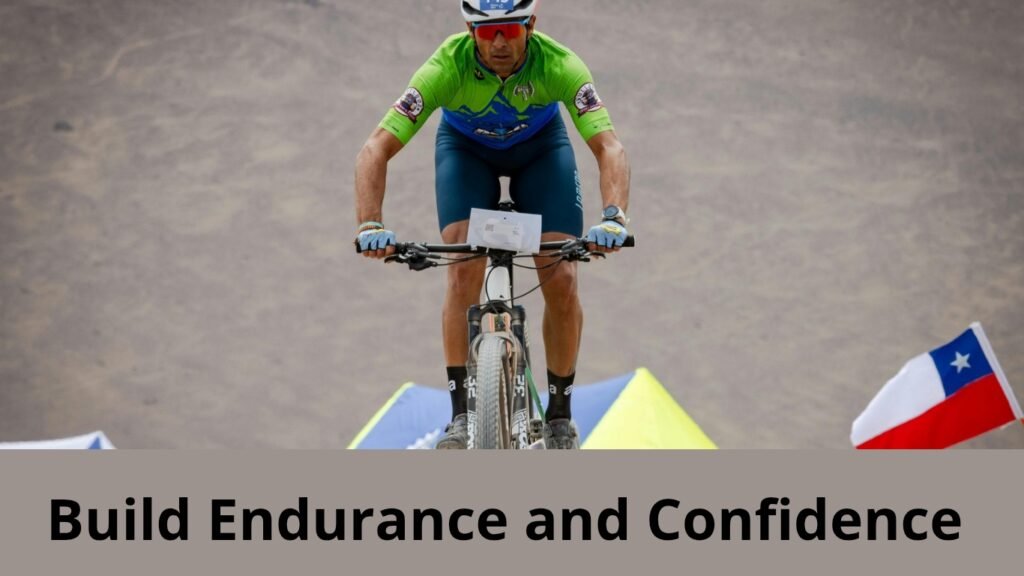Fitness is very important for mountain biking; being one of the most adventurous sports, you need stamina, endurance, and skills to enjoy it fully.
So, in this guide, we will discuss a four-week training plan that is specifically for beginners to build endurance, strength, and skills.
If you follow this program, you will be able to ride your mountain bike confidently on different types of trails, like rocky climbs, forest trails, etc.
So, to start this MTB training plan, you just need a simple thing:
A properly tuned MTB, and some gear like a helmet, gloves, and, of course, mountain biking clothes, like padded shorts for safety and comfort.
Besides this, it’s also good to have some basic tools like tire levers, a spare tube, a pump, and multi-tools so that you can fix any problem that occurs while training.
Also read: MTB Pre Ride Checklist Every Should Know
Week 1 – Building Endurance and Confidence (Laying the Foundation)

In the first week of mountain bike training, your focus should be learning basic mtb handling techniques and improving endurance. The first week of training will also boost your confidence.
Also read: Important safety gear for mountain biking
Day 1: Easy Ride – 30–45 Minutes
On the first day, you will keep everything simple because on this day, you will focus on building rhythm and endurance.
So you first want to find a simple path where you can ride for 30-45 minutes; remember, it shouldn’t be tricky terrain.
Key Actions:
You want to pedal constantly and smoothly around 70-90 rpm and also avoid speeding up or slowing down suddenly. Just focus on the rhythm or momentum.
Besides this, you can also monitor your heart rate to ride at a pace where you can have a conversation without gasping for air. Plus, you want to focus on your posture.
Your body needs to be slightly bent for better stability, and while doing that, keep your elbow loose to absorb shock.
Additionally, also focus on deep and controlled breathing, especially when you are riding on inclined terrain, to avoid fatigue.
Also read: Strength Training for Mounting Biking
Day 2: Skills Practice – 30 Minutes
Focus: Developing core bike handling skills
On the second day, you will focus on building core bike handling skills. So You first want to find a park or a ground to practice biking without worrying about anything like a crowd or any other obstacle that makes you feel less focused.
Key Drills:
You want to practice balancing your bike when you stop; it’s an important skill on technical terrain, as bikes often have to stop there.
Try to keep your feet off the ground when you stop the bike and try to hold it as long as possible; it helps build balance.
Besides this, learning how to turn your bike correctly is also important, so you need to find a smooth corner and then practice turning the bike smoothly.
Make sure to keep your body relaxed, especially your arms and hands.
Lastly, in bike control, you want to use both your hands to break smoothly. It’s also better to avoid sudden front and rear brakes at the same time.
Key Tip: Many bikers grip handlebars too tightly and don’t relax their body, especially those who are beginners. So you should avoid these common and minor mistakes.
Also read: How to make the core strong for better stability during MTB riding
Day 3: Rest or Recovery Ride – 20 Minutes
The third mountain bike training day is not going to be very tough. You just want to take a rest and allow your muscles to recover completely and prevent any soreness.
Now, on this day, you can take a complete rest, or if you wish to, you can ride for 10 to 20 minutes on a simple and flat terrain where you don’t have to make much effort. This is important to prevent over-training.
Besides this, if you want, you can also do stretching or foam rolling to relieve tightness in muscles.
Day 4: Hill Repeats – 30–45 Minutes
The fourth day is all about building strength for mountain biking and improving climbing techniques.
So you first have to find a short hill which is moderate in climb. It can be around 1 to 2 minutes long.
After finding a hill, you want to climb it at a steady speed while maintaining momentum. Don’t try to go too slow or rush.
Plus, you can also shift gear early to maintain momentum.
Besides this, when you are climbing, make sure you stay seated to maintain traction. But if you need power, you can stand briefly to engage different muscle groups.
However, After reaching the top of the hill, you want to come down, and at that time, you will allow your body to recover.
You can repeat this process 4 to 6 times at least a day.
Tip: Consistency is the most important thing that will help you build strength and climbing techniques.
Also read: Best Warm-up exercises for mountain bikers
Day 5: Skills + Easy Ride – 45 Minutes
On the 5th day, you will combine Day 1; and Day 2 training, which means Skills and Easy Ride, to reinforce handling techniques.
So, you will need to choose a gentle trail, which is not too technical but still has some climbs and descents, so that you can practice body positioning.
Besides this, when you ride, make sure to practice MTB skills like cornering, braking drills, pedal-breaking drills, etc.
Also, keep the body and grip relaxed and try to mimic it as if you’re riding in real, real conditions (Where you want to ride in the future).
Day 6: Long Ride – 60–90 Minutes
This day is going to be the longest day of the week. Maybe you could feel it after riding for 70 to 90 minutes, even more, if you wish to, but that’s what I would recommend riding at least.
However, you want to choose a road with rolling terrain, which has some small climbs and descents as well.
You will focus on maintaining a steady and moderate speed for a longer duration. It will help you build endurance.
So that in the future, you can cover longer distances on various trails without getting tired.
During the training, you want to ride constantly with steady efforts if you feel good when you are closer to the end.
For example, you are riding for 90 minutes, but if you are okay after riding for 80 minutes, then in the last 10 minutes, you can increase the speed and push yourself harder towards the end.
However, you have to finish the ride without feeling executed. Meanwhile, keep your body posture right, especially when you are riding up and down climbs.
Make sure your weight is centered so you are pedaling smoothly.
Day 7: Rest and Recovery
You can fully relax on the last day of the week to allow your muscles to recover completely.
However, you can still do some light activities like stretching, foam rolling, or yoga, whichever you like.
These light activities will prevent tightness and muscle soreness and will also relax your body.
On the last day of the week, don’t forget to hydrate and fuel your body properly.
Week 2 – Building Strength and Handling Skills

From the second week of mountain bike training, your focus should be building climbing strength, technical skills, and cornering ability.
Day 1: Climbing Intervals (45 Minutes)
Focus: Build climbing strength and stamina
On the first day of the second week, you want to do interval training to improve your climbing power and endurance.
It will help you push yourself on inclining trails or climbing terrains.
You first want to ride your bike for at least 10 minutes on a normal surface (It will be your warmup). You can use flat terrain.
After this, you will need a moderate hill where you can do climbing practice for at least two minutes. Then, rest for at least 5 minutes.
You want to repeat this process for at least 4 to 6 times. And you can also adjust it based on your fitness level. But 4 to 6 times is normal.
Day 2: Technical Skills Practice (40 Minutes)
Due to the lack of mountain biking skills, it is hard for beginners to handle technical terrain.
Therefore, on the second day, you want to focus on that so that you can easily navigate obstacles and ride on any technical section with confidence.
The front wheel lift is one of the most common mountain biking skills that you want to learn.
This skill will help you tackle small obstacles like rocks or curbs. You want to start it at a slow speed by lifting the front wheel from your arm and pulling it back slightly on the handlebar.
The second skill is learning bunny hops.
So, you will practice hopping both wheels off the ground to clear obstacles like logs.
In this, you want to pull the handlebars and use your leg to push the bike upward.
The third skill for technical riding you want to learn is slowing down bike speed with balance.
To practice this, you have to ride as slowly as possible without touching the ground from your feet. It will help you improve your balancing skills, which will be very helpful in the technical section.
To maintain your balance at the slowest speed, you want to keep your eyes forward and make a little in your handlebars; it will also help create balance.
Also read: Essentials tips for safety during mountain bike riding
Day 3: Recovery Ride (20 Minutes)
After working hard on the second day, on the third day, you will want to rest and allow your muscles to relax and recover properly.
Besides recovering, the rest day will also promote circulation and help you avoid any fatigue.
On this day, if you wish to, you can do some simple stretching like leg and back stretch to prevent any stiffness that bikers often get after riding a lot.
It’s also good to do yoga or meditation, especially deep breathing, to stay relaxed throughout the ride.
Day 4: Trail Ride Focused on Corners (60 Minutes)
The fourth day of mountain bike training is to master turns because cornering is very common, especially when riding in forest areas.
First, you have to find a place with turns or corners, and then, you need to look ahead to where you want to go (A little ahead from the corner) where you will turn.
It will make your mind naturally command your body to turn.
After that, instead of leaning your body, you want to push the bike into the corner while keeping your body weight in the center.
Because some new riders also lean, which isn’t good. Some riders end up falling down.
Pro tip: However, while entering a corner, brake slightly before turning around to lower speed and try to exit the turn without accelerating to keep the speed in control.
Day 5: Sprint Intervals (45 Minutes)
On the fifth day, you should do sprint interval training. It will improve your power, speed, and cardiovascular fitness, which is important in technical trails or when overtaking.
First of all, you should do some stretching for at least 10 minutes. You can also do push-ups to warm up your body.
After that, you will sprint for at least 20 seconds at a shorter distance. It can be like 20 meters, 50 meters, or something else, depending on the ground size.
However, you want to use your explosive strength to generate maximum power and keep your cadence high.
After that sprint, you want to shift to an easy gear and spin at a slow cadence for at least 45 seconds to recover before the next sprint.
After, you will again start sprinting as you did previously, and you will repeat this process 8 to 10 times, but again, it depends on your fitness level.
However, I would recommend it at least 6 times if you are a beginner. You can also increase the distance, like riding a bike with full strength for 100 meters and then riding slowly for 45 seconds to recover.
Day 6: Long Ride – 90 Minutes
On the 6th day of mountain biking training, you will focus on endurance climbing and technical handling skills.
This Longer Ride will test what you have learned over the week. It also will test your ability to maintain endurance and other skills too, such as technical riding.
Firstly, you want to choose a road or trail with a mix of climbs, descents, and technical sections, where you will ride for at least 90 minutes at moderate speed.
First, you will focus on climbing techniques that you have learned on your 1st day, pedaling smoothly.
Secondly, you will do technical handling. On this ride, you will also try to tackle some challenging terrain like loose gravel, roots, and rocks.
Pro tip: Don’t try to rush; just go with the confidence, keep yourself, and keep your body relaxed.
Day 7: Rest or Yoga
The last day of the week needs to be reserved for recovery and some flexibility training.
So you would have worked hard in the second week, that’s why you will need rest. However, you can do some stretching and yoga.
Some of the good yoga poses that you can do are child’s pose, downward dog, cobra pose, and seated forward fold. These yoga poses will make your body more flexible and relieve any tight muscles.
Week 3 – Endurance and Technical Mastery

In the third week, your main goal is to build stamina for longer rides and to tackle tough terrain.
Day 1: Steady Climb Ride (60 Minutes)
You need to find steady climbs with longer routes for practice, and you want to ride there consistently.
It will help you build climbing endurance and will refine your techniques, which you have learned in weeks 1 and 2 to tackle extended inclines.
You don’t need to go super fast but avoid going at slow speed as you would have practiced in previous weeks.
But make sure you pedal smoothly to avoid fatigue. You can also shift gear earlier to maintain momentum and try to keep breathing mindfully.
Day 2: Technical Trails (60 Minutes)
You need to find a trail mix of a rocky section, tight switchbacks, and some small drops to practice balance and weight distribution and learn how to tackle rough terrain.
This type of mixed train will improve your ability to navigate tough terrain.
When riding through a Rocky area, make sure to ride smoothly with a controlled cadence.
You should also try to lift your front wheel slightly over the rock, using your body to absorb impact.
Plus, you need to lean the bike through tight turns while keeping the weight in the center.
When you see some small drops, you want to shift your weight slightly to prevent the wheel from hitting too hard.
Day 3: Recovery Ride or Walk (30 Minutes)
Day 3 of the 3rd week of mountain bike training needs to be a relaxation day for light muscle recovery.
But if you want to ride, then you can do it just for a few minutes, like 10 to 20 but at low speed.
Or you can simply walk to promote blood flow and allow your muscles to recover properly because you would have done work in the last 2 days.
However, more than an easy ride on day 3, which is the relaxation day, I prefer walking in nature to relax my muscles and have a mental break.
Day 4: Interval Training (60 Minutes)
After the relaxation day, on the fourth day, you want to do interval training to build cardiovascular fitness and power. Plus, you will also focus on improving your speed.
So, you first need to find a place to ride, and then there, you will ride at a fast speed for at least 5 minutes. Meanwhile, you will try to push yourself while maintaining control.
After that, you will take a 3-minute break for recovery, but you don’t have to stop here; you will just slow down your speed for 3 minutes, which is the recovery period.
Just stay relaxed and allow your heart to return to its normal rate.
You want to do this process at least 4 times. And that is the minimum. If your fitness is good, you can do it as long as you are okay.
Day 5: Trail Simulation Ride (90 Minutes)
You want to choose a loop that includes various obstacles that you might encounter in a race, like climbs, rocks, and descents, to prepare your body for a tough ride.
First of all, you want to tackle short, steep climbs at a steady pace while practicing smooth gear shift safety.
Besides this, you will work on navigating over the rocks and root through trails while performing mountain biking skills, which we have also discussed before, like the bunny hop, lifting the front wheel, etc.
Make sure you keep your body weight in the center to balance the bike. And lastly, when you are riding on a descent, keep the weight back and your arms and legs slightly bent to absorb shock.
On day 5th, try to maintain a race-like intensity, as if you are in a race. It will prepare you mentally and physically.
Day 6: Long Ride – 2 Hours
On day 6 of the third week of mountain bike training, you will push your endurance with more climbing and descent, and you will ride for at least 2 hours.
Because in the previous week, you rode for 60 to 90 minutes.
Now, a minimum of 2 hours is okay; you can increase it more if you wish to.
However, the main goal on day 6 is to extend your stamina and handle longer rides for more challenging terrain.
So, you first want to choose a mixed terrain that includes descent, climbs, and some technical sections to test your endurance. Initially, you will ride at normal speed, but gradually, you will increase it.
Ride as long as you don’t start to feel fatigued (but not completely); you can stop when you just start feeling like that, or you can just slow down by speed.
Day 7: Rest
Day 7 allows your body to recover completely, so it will be a full rest day, as day 6 was very busy.
However, you can do some stretching or yoga poses, like the cobra stretch.
Week 4 – Peak Performance and Trail Readiness

The fourth and final week is all about peak performance.
So you will combine fitness and technical skills into longer and more demanding rides, and you will test everything that you learned in the past 3 weeks of MTB training.
Day 1–3: High-Intensity Rides (45–60 Minutes)
For the first 3 days of 4th week, you will push yourself harder on climbs, descents, and sprints to push your lead limit and test your ability to handle high-intensity effort.
You have to find a trail mix of climbs, descents, and sprints to simulate physical demand for challenging trails.
You want to maintain a steady, hard pace while pedaling smoothly. While riding descents at high intensity, also focus on maintaining control and trying to navigate obstacles.
Besides this, you can sprint for at least 30 seconds and rest for 1-2 minutes while riding slowly. Then, again sprinting for 30 seconds.
You will keep doing this process as long as you can. The total period of this training will be 45-60 minutes.
Day 4: Recovery Ride or Yoga (30 Minutes)
The fourth day is dedicated to recovery rides and yoga, which you can do for at least 30 minutes to relax your muscles and improve flexibility.
Some of the best yoga poses that you can do are a downward dog, child’s pose, and cobra pose to improve flexibility and relax your muscles.
Besides this, you can also go for a ride, but at a normal pace. You won’t try to do anything special like performing skills, etc. You will be recovering your body and muscles.
Day 5: Test Ride (2 Hours)
On the 5th day, you will test everything that you have learned so far in the last 3 weeks and 4 days.
You will test everything on a real-world trail. Plus, you want to treat the 5th day as an event to evaluate your progress.
You will choose the trail with climb, descend, and technical sections to test your skill.
You will maintain a steady pace while applying all the mountain biking skills that you have been practicing.
Besides this, you will also simulate race conditions where you will try to ride as if you are in a race, especially on climbs.
After a ride, you want to evaluate how well you have handled each section of the trail. Then, you identify an area where you have to work more.
For example, you could not navigate an obstacle through bunny hop skills.
So you will work on that specific skill to become a way better mountain bike rider than you were.
Day 6: Recovery Ride (30 Minutes)
After the 5th-day testing ride, keep the day 6 very simple.
You can have a light ride to help your muscles recover after a busy day. But don’t ride too much. Thirty minutes is okay.
However, you can also do stretching to relieve any tightness in the leg, back, and arms.
Day 7: Rest and Reflect
The final day of your mountain bike training for 4 weeks. So you can rest completely and reflect on your progress.
You can celebrate the achievement that you have achieved like you’d have learned a few mountain biking skills like cornering, balancing on incline trails, Improved stamina, etc.
You can think how much harder you have worked to achieve all of this.
Most importantly, you can plan your future goals, like where you want to ride, as there are many trails in the USA and even in many other countries as well.
So, you can plan your mountain bike trip even to Europe. However, I would still recommend riding in your own country rather than an international trip.
Also read: How to plan mountain bike backpacking
Final Thoughts
After 4 weeks of mountain bike training, you will notice a huge improvement in yourself and in your skill set.
You will realize that you have learned many skills, and now you can ride on various trails, including inclines, declines, technical sections, smooth trails, etc, without even getting tired.
Plus, you can now easily navigate obstacles like root, which bikers often face while on forest trails.
Besides this, your fitness level would have increased a lot. However, all this would be possible after a consistent effort, so make sure not to skip a day.
I wish you all the best in these 4 weeks of training for better results.
Also read: 27 Best trails in the United States that you should never miss
How many days a week should I mountain bike to improve?
If you are a beginner, you can ride 2 to 3 times per week, but some intermediate and experienced riders prefer to train 4 to 6 times a week.
However, recovery is the most important thing. For example, if you train for 6 days as a beginner but cannot recover, you have to train for 4 to 5 days and give yourself more time to recover.
Plus, always listen to your body and do cross-training activities like strength training and swimming to improve your mountain biking performance.
What are the most important exercises for mountain biking strength training?
There are many strength and stability exercises for mountain biking, such as squats, deadlifts, lunges, and push-ups to strengthen your lower body.
Pull-ups for row strength to improve your back and pulling power, which you will need for climbing and technical sections. The improved core is important, too, for balance so that you can do planks, Russian twists, etc.
How can I improve my mountain bike climbing?
Mountain bike climbing is a bit hard. That’s why you want to make yourself strong. So, you will need to build strength, techniques, and pace.
You can do squats, hill repeats, and lunges to make your legs strong. Plus, practice maintaining a smooth cadence and efficient pedaling techniques.
Besides this, you should do hill repeats. To do this, you have to find a moderate hill where you can ride within 1-2 minutes.
The plan is simple: You will ride at high speed, and after reaching the top, you will rest for a few seconds and then come down.
Then repeat this process 4-6 times as a beginner. This will also build your habit of climbing uphill trails without getting tired too quickly.

Ali is the founder of Mountain Bike Insider and an passionate rider with years of hands-on experience in mountain biking. From testing gear to exploring trails, Ali writes based on real riding knowledge to help others make smart, safe, and enjoyable biking choices. Every guide is built on research, personal use, and a passion for the sport.







